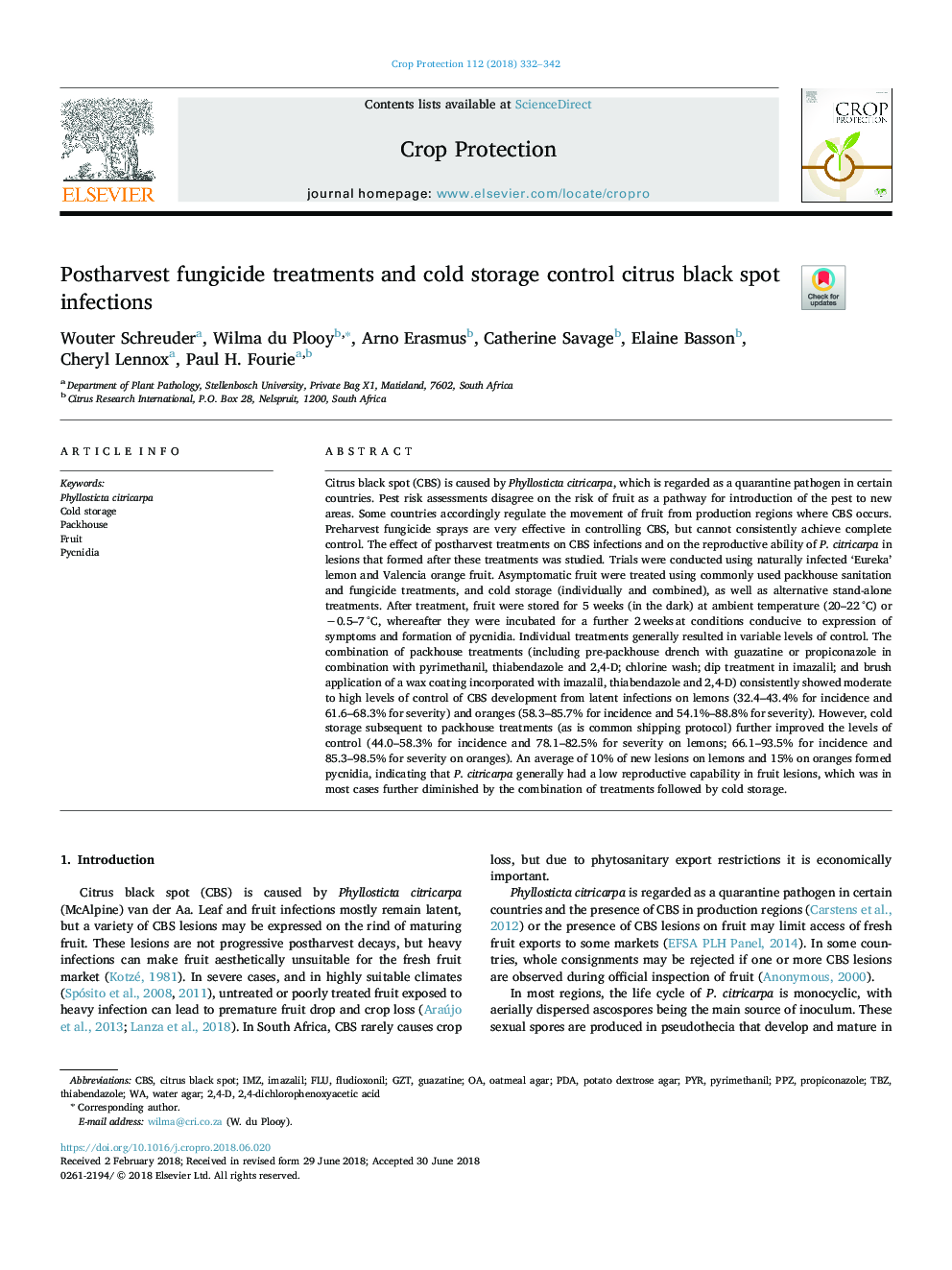| کد مقاله | کد نشریه | سال انتشار | مقاله انگلیسی | نسخه تمام متن |
|---|---|---|---|---|
| 8877993 | 1624275 | 2018 | 11 صفحه PDF | دانلود رایگان |
عنوان انگلیسی مقاله ISI
Postharvest fungicide treatments and cold storage control citrus black spot infections
ترجمه فارسی عنوان
درمان های قارچکش پس از زایمان و کنترل ذخیره سازی سرد عفونت های نقطه مرکزی
دانلود مقاله + سفارش ترجمه
دانلود مقاله ISI انگلیسی
رایگان برای ایرانیان
کلمات کلیدی
PPZGuazatinePDACitrus black spotImazalilPhyllosticta citricarpaTBZFludioxonilPYRCBS2,4-D - 2،4-D2,4-dichlorophenoxyacetic acid - 2،4-dichlorophenoxyacetic اسیدthiabendazole - تیبندازولCold storage - ذخیرهسازی سردFlu - سرفهpotato dextrose agar - سیب زمینی دگزستروز آگارIMZ - قلمرو کوهستانیFruit - میوهPropiconazole - پروپی کینازولPyrimethanil - پیریمتانیل
موضوعات مرتبط
علوم زیستی و بیوفناوری
علوم کشاورزی و بیولوژیک
علوم زراعت و اصلاح نباتات
چکیده انگلیسی
Citrus black spot (CBS) is caused by Phyllosticta citricarpa, which is regarded as a quarantine pathogen in certain countries. Pest risk assessments disagree on the risk of fruit as a pathway for introduction of the pest to new areas. Some countries accordingly regulate the movement of fruit from production regions where CBS occurs. Preharvest fungicide sprays are very effective in controlling CBS, but cannot consistently achieve complete control. The effect of postharvest treatments on CBS infections and on the reproductive ability of P. citricarpa in lesions that formed after these treatments was studied. Trials were conducted using naturally infected 'Eureka' lemon and Valencia orange fruit. Asymptomatic fruit were treated using commonly used packhouse sanitation and fungicide treatments, and cold storage (individually and combined), as well as alternative stand-alone treatments. After treatment, fruit were stored for 5 weeks (in the dark) at ambient temperature (20-22â¯Â°C) or â0.5-7â¯Â°C, whereafter they were incubated for a further 2â¯weeksâ¯at conditions conducive to expression of symptoms and formation of pycnidia. Individual treatments generally resulted in variable levels of control. The combination of packhouse treatments (including pre-packhouse drench with guazatine or propiconazole in combination with pyrimethanil, thiabendazole and 2,4-D; chlorine wash; dip treatment in imazalil; and brush application of a wax coating incorporated with imazalil, thiabendazole and 2,4-D) consistently showed moderate to high levels of control of CBS development from latent infections on lemons (32.4-43.4% for incidence and 61.6-68.3% for severity) and oranges (58.3-85.7% for incidence and 54.1%-88.8% for severity). However, cold storage subsequent to packhouse treatments (as is common shipping protocol) further improved the levels of control (44.0-58.3% for incidence and 78.1-82.5% for severity on lemons; 66.1-93.5% for incidence and 85.3-98.5% for severity on oranges). An average of 10% of new lesions on lemons and 15% on oranges formed pycnidia, indicating that P. citricarpa generally had a low reproductive capability in fruit lesions, which was in most cases further diminished by the combination of treatments followed by cold storage.
ناشر
Database: Elsevier - ScienceDirect (ساینس دایرکت)
Journal: Crop Protection - Volume 112, October 2018, Pages 332-342
Journal: Crop Protection - Volume 112, October 2018, Pages 332-342
نویسندگان
Wouter Schreuder, Wilma du Plooy, Arno Erasmus, Catherine Savage, Elaine Basson, Cheryl Lennox, Paul H. Fourie,
